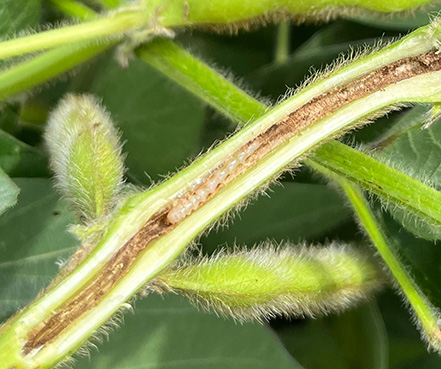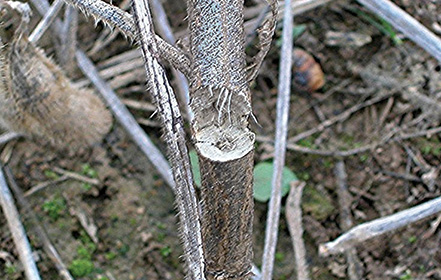
The Dectes stem borer, Dectes texanus LeConte (Coleoptera: Cerambycidae), is an insect pest native to North America. It was first reported infesting soybeans in Missouri in the 1960s. Dectes stem borer hosts include annual weeds such as ragweed, Ambrosia spp., cocklebur, Xanthium strumarium L., and cultivated sunflower. Currently, the Dectes stem borer is found infesting soybeans across the main production areas in the United States, including Missouri.
Insect description

Adults are small, gray, long-horned beetles about 3/8 inch long and somewhat flattened, with long, slender antennae. Antennae have dark, transverse bands and are longer than the body (Figure 1). Eggs are elongated, shiny, tapered on both ends, and average 5/64 inch in length and 1/64 inch in width. Initially, the eggs are yellowish and darken to an amber color just before the larvae hatch. Egg incubation ranges from 6 to 10 days. Newly hatched larvae are creamy white but darken as they mature. Larvae have an “accordion-like” appearance with an orange-red head and reach about 1/2 to 5/8 inch long when fully mature (Figure 2). Pupae are yellowish white and become dark brown close to adult emergence.
Damage

Dectes stem borer can cause direct and indirect damage to soybeans. During oviposition, the female chews the petiole, leading to wilting of the petiole and leaf abscission. Direct yield loss from the larvae feeding in the pith is considered minimal. However, when yield loss from tunneling does occur, it is probably an interaction with other negative environmental conditions (such as drought). The primary source of yield loss from the Dectes stem borer is indirect from lodging. Larvae tunneling and girdling into stems weaken them, making the plant very susceptible to lodging, a great potential for yield losses.

Life cycle
Dectes stem borer has a single generation per year. This species overwinters as mature larvae within the stems of its host plants, and the adult beetles begin emerging sometime in June or early July. After mating, the female beetle chews a small hole in the leaf petiole or the stem (Figure 3) and typically lays a single egg inside. The newly emerged larva feeds on the petiole and tunnels into the soybean main stem. As the larva tunnels within the main stem, it feeds on the pith tissue. In late summer, the larvae move to the base of the plant and girdle the interior of the stem approximately 2 inches above the soil surface (Figure 4). The larva creates a sealed chamber below the girdling point, where it may or may not undergo additional molts during the winter months (Figure 5). In Missouri, pupae are observed in late Spring.
Scouting and management

Dectes stem borer populations tend to be more abundant on field edges near weeds such as cocklebur and ragweed, adjacent to last year’s soybean fields, or continuous soybeans. In general, a no-tillage system and a lack of crop rotation can favor Dectes stem borer populations. Dectes stem borer scouting is recommended from July through August when adults emerge. A sweep net can be used to scout for adults, while the presence of larvae and larval tunneling can be determined by splitting the soybean stems. While this can help growers verify the presence and abundance of Dectes stem borer in the fields, there is no threshold level for this pest.
A few insecticides are registered for Dectes stem borer control. While these insecticides will kill the adults, applications are generally not recommended because it is extremely difficult to time the sprays properly. Emergence of the adult beetles is typically spread out over several weeks, thus requiring multiple applications to effectively control this pest.
Several cultural practices can be effectively employed to help reduce stand and yield losses from Dectes stem borer damage:
- Effective control of weed host plants (e.g., cocklebur, giant ragweed) within and around fields is necessary to reduce the number of preferred egg-laying sites for the female beetles.
- Scout soybeans at several locations throughout the field before maturity for tunneling and live larvae. Fields with high percentages of infested stems should be harvested as soon as possible to help reduce losses associated with lodged plants.
- Avoid planting soybeans in fields adjacent to fields that were heavily infested the previous year. Rotate crops to reduce insect pressure.
- Fall tillage can increase overwintering mortality of Dectes stem borer larvae. Plant stubble should be buried at least 2 to 3 inches.
- Certain soybean varieties have shown reduced damage, but these soybean varieties are not commercially available.